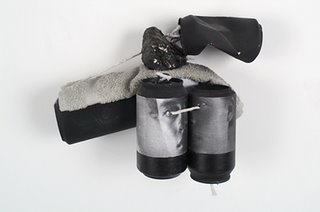Monday, December 11, 2006
The Chosen Cans
Paul Lee goes for great eschatological themes: love and the body. The TD crew usually frowns on sentimentialism, but the formal rigor dignifies this show of collages and assemblages, art forms based on joinery - on coupling.

His materials include soda cans, washcloths, twine, lightbulbs, coal, and photocopied images. In the philistine, mundane real world, each of these objects can expect an uninspired, brief life of being produced, being consumed, and being discarded. They have no agency, only a passive role in a cycle of drudgery.
Paul Lee resuscitates them, The Chosen Trash, saving them from their predetermined path of banality, and recycling - resurrecting - them as art objects. Though revitalized, the cans are painted only black or white, ascetic and undecorative colors. These flat, opaque colors obscure the cans' marketing labels and previous content. Now empty, they are no longer vessels auxiliary to their contents. Absolved of these burdens, they stand freely as objects, purified and independent of a mercantile purpose, which fades into a vestigious trait.

The cans and bulbs flaunt rigid, consistent geometry and smooth, unfettered surfaces. But they are challenged by the sagging, eccentric washcloths with unpredictable textures. We think of the body, with its strong parts and vulnerable parts, clean parts and dirty. Through Lee's transfiguring hands, these refigured figures are odd dolls, soft and hard, fragmented but unified, sturdy but delicate.
Transfigured, the cans no longer have design, but now anatomy. Cylindrical, they are phallic and ostentatious. But the prominent hole at one end is an orifice, either an entry or an exit. It is also a window into a hidden, unadvertised world. Some are dented, a clever pun on the word "crush," but more poignantly, this expresses damage, injury, or dysfunction. Finally, the black-and-white pictures of faces pasted on the cans are anonymous. They aren't recognizable or distinct people, just males. It adds gender to the figures without adding personality - although the inherent melancholy is undeniable.


A wall of washcloths takes on issues in painting, similar to Tuttle's experiments in eliminating frames, stretcher bars, rectangular shape, and balanced display. But Lee surpasses this formal project to comment on relationships. First, each cloth, like each can, previously lived an uninspired life. It cleaned and occasionally was cleaned. It may have even joined its owner on a trip to the bathhouse, ostensibly for hygiene.


Second, each "cloth painting" is made from two halves spliced together from other cloths. They cling together, splayed open on the wall by gravity. We think of Felix Gonzales-Torres' Perfect Lovers, the parallel mirrors next to each other, or the analog clocks ticking away; and Apollodorus' explanation in Plato's Symposium: love is the result of a person finding his or her estranged other half. And Aristotle: "Love is composed of a single soul inhabiting two bodies."


His materials include soda cans, washcloths, twine, lightbulbs, coal, and photocopied images. In the philistine, mundane real world, each of these objects can expect an uninspired, brief life of being produced, being consumed, and being discarded. They have no agency, only a passive role in a cycle of drudgery.
Paul Lee resuscitates them, The Chosen Trash, saving them from their predetermined path of banality, and recycling - resurrecting - them as art objects. Though revitalized, the cans are painted only black or white, ascetic and undecorative colors. These flat, opaque colors obscure the cans' marketing labels and previous content. Now empty, they are no longer vessels auxiliary to their contents. Absolved of these burdens, they stand freely as objects, purified and independent of a mercantile purpose, which fades into a vestigious trait.

The cans and bulbs flaunt rigid, consistent geometry and smooth, unfettered surfaces. But they are challenged by the sagging, eccentric washcloths with unpredictable textures. We think of the body, with its strong parts and vulnerable parts, clean parts and dirty. Through Lee's transfiguring hands, these refigured figures are odd dolls, soft and hard, fragmented but unified, sturdy but delicate.
Transfigured, the cans no longer have design, but now anatomy. Cylindrical, they are phallic and ostentatious. But the prominent hole at one end is an orifice, either an entry or an exit. It is also a window into a hidden, unadvertised world. Some are dented, a clever pun on the word "crush," but more poignantly, this expresses damage, injury, or dysfunction. Finally, the black-and-white pictures of faces pasted on the cans are anonymous. They aren't recognizable or distinct people, just males. It adds gender to the figures without adding personality - although the inherent melancholy is undeniable.


A wall of washcloths takes on issues in painting, similar to Tuttle's experiments in eliminating frames, stretcher bars, rectangular shape, and balanced display. But Lee surpasses this formal project to comment on relationships. First, each cloth, like each can, previously lived an uninspired life. It cleaned and occasionally was cleaned. It may have even joined its owner on a trip to the bathhouse, ostensibly for hygiene.


Second, each "cloth painting" is made from two halves spliced together from other cloths. They cling together, splayed open on the wall by gravity. We think of Felix Gonzales-Torres' Perfect Lovers, the parallel mirrors next to each other, or the analog clocks ticking away; and Apollodorus' explanation in Plato's Symposium: love is the result of a person finding his or her estranged other half. And Aristotle: "Love is composed of a single soul inhabiting two bodies."

Comments:
<< Home
Thanks, cooky. That's the easiest part and we still forget it often...
Paul Lee at Massimo Audiello, 526 W 26th, 5th floor.
Post a Comment
Paul Lee at Massimo Audiello, 526 W 26th, 5th floor.
<< Home

